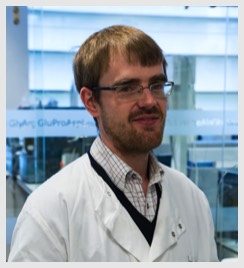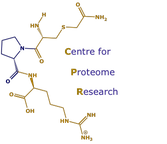
Dr Philip Brownridge
Postdoctoral Researcher
LabA, Centre for Proteome Research
Institute of Integrative Biology
University of Liverpool,
Crown Street
Liverpool L69 7ZB
Tel: +44 151 794 5344
Tel: +44 151 795 4392
Email: dsimpson[at]liv.ac.uk
Postdoctoral Researcher
LabA, Centre for Proteome Research
Institute of Integrative Biology
University of Liverpool,
Crown Street
Liverpool L69 7ZB
Tel: +44 151 794 5344
Tel: +44 151 795 4392
Email: dsimpson[at]liv.ac.uk
I started my scientific training as an undergraduate at UMIST reading biochemistry. Towards the end of my degree I was attracted by bioinformatics so I enrolled in the UMIST MSc Computation course and completed a summer research project which used text mining to investigate gene promoter sequences. Towards the end of this project I was offered a PhD opportunity in the Michael Barber Centre for Mass Spectrometry under the supervision of Prof S. Hubbard and Prof. S. Gaskell. This PhD project was split between lab biology and bioinformatics and served as my introduction to proteomics. The main goal of the project was to use chemical crosslinkers to study protein-protein interactions. This project focused on the characterization of modified proteins and peptides by mass spectrometry and on the software to identify modifications. The project produced software that could identify crosslinked species and produced proof of principle data by mapping the subunit interface of some homodimeric test proteins.
My first postdoctoral position within the Protein Function Group (PFG) at the University of Liverpool and was a project aimed to investigate the role of protein isoforms in the relaxation rate of fast twitch muscle fibres. This project involved characterization of the differences between the isoforms, followed by the quantification of the abundance and turnover of the isoforms.
My second post within the PFG was part of a two centre project to provide absolute quantification data for the yeast proteome. This project is based on QconCAT technology, which is a mass spectrometry based protein quantification strategy, developed by the PFG, and targeted mass spectrometry and between the two sites has produced quantification values for over a thousand yeast proteins. I have now settled into a role maintaining the performance of the PFG in terms of instrument performance, training of personnel and ensuring that our protocols follow the latest techniques and methods.
My research history three projects have given me a wide knowledge of proteomics from classical protein chemistry through to cutting edge mass spectrometry. The protein crosslinking project required knowledge of protein chemistry and employed protein and peptide derivatisation, MS techniques to detect low abundance modified peptides against a complex background including LC-MS/MS. Characterisation of the protein isoforms required two-dimensional electrophoresis, determination of turnover was performed by dynamic SILAC and quantification of the isoforms, the use of targeted mass spectrometry.
cont’d…
My first postdoctoral position within the Protein Function Group (PFG) at the University of Liverpool and was a project aimed to investigate the role of protein isoforms in the relaxation rate of fast twitch muscle fibres. This project involved characterization of the differences between the isoforms, followed by the quantification of the abundance and turnover of the isoforms.
My second post within the PFG was part of a two centre project to provide absolute quantification data for the yeast proteome. This project is based on QconCAT technology, which is a mass spectrometry based protein quantification strategy, developed by the PFG, and targeted mass spectrometry and between the two sites has produced quantification values for over a thousand yeast proteins. I have now settled into a role maintaining the performance of the PFG in terms of instrument performance, training of personnel and ensuring that our protocols follow the latest techniques and methods.
My research history three projects have given me a wide knowledge of proteomics from classical protein chemistry through to cutting edge mass spectrometry. The protein crosslinking project required knowledge of protein chemistry and employed protein and peptide derivatisation, MS techniques to detect low abundance modified peptides against a complex background including LC-MS/MS. Characterisation of the protein isoforms required two-dimensional electrophoresis, determination of turnover was performed by dynamic SILAC and quantification of the isoforms, the use of targeted mass spectrometry.
cont’d…

B.Sc. UMIST
Ph.D. UMIST
Ph.D. UMIST
cont’d…
The yeast protein quantification project required high throughput targeted mass spectrometry and has allowed me to become an expert in label and label free quantification of proteins. I have analytical and maintenance experience on a wide variety of proteomic equipment including mass spectrometers: MALDI-ToF (Bruker UltraFlex), triple quadrupole mass spectrometers for targeted analysis (Waters Xevo TQ and TQS) and the high resolution mass spectrometers necessary for modern proteomic analysis (Thermo Scientific Orbitrap Velos and QExactive, Waters Synapt G2); and also the accompanying nanoflow LC equipment (Waters NanoAquity and Thermo Scientific 3000 RSLC).
The yeast protein quantification project required high throughput targeted mass spectrometry and has allowed me to become an expert in label and label free quantification of proteins. I have analytical and maintenance experience on a wide variety of proteomic equipment including mass spectrometers: MALDI-ToF (Bruker UltraFlex), triple quadrupole mass spectrometers for targeted analysis (Waters Xevo TQ and TQS) and the high resolution mass spectrometers necessary for modern proteomic analysis (Thermo Scientific Orbitrap Velos and QExactive, Waters Synapt G2); and also the accompanying nanoflow LC equipment (Waters NanoAquity and Thermo Scientific 3000 RSLC).
